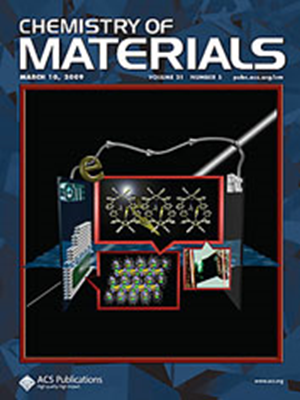Discovering Perovskite-Derived Tungsten Bronzes from In Situ Diffraction of Electrochemical Rubidium and Cesium Intercalation
IF 7
2区 材料科学
Q2 CHEMISTRY, PHYSICAL
引用次数: 0
Abstract
Perovskite-derived tungsten bronzes are formed from tungsten oxide by electrochemical intercalation of all alkali metals from aqueous solutions. In two steps, we yield two different polymorphs, where the first step is reversible and the second step is irreversible. The electrochemical approach affords precise control of the composition, while ex situ X-ray diffraction and particularly in situ X-ray diffraction allow the analysis of the atomic structure. For the heavy alkali metals, rubidium and cesium, the in situ synchrotron X-ray diffraction experiments reveal in sum four new structures and their formation process. The irreversible deintercalation step yields at room temperature, the α-WO3 phase, a tungsten oxide polymorph which is thermodynamically only stable above 1073 K. Finally, analyzing the full alkali metal series allows us to conclude that the symmetry and structure of the formed bronzes are dictated by the electron count on the tungsten oxide network and the size of the ions plays a negligible role.

从电化学铷和铯插层原位衍射发现钙钛矿衍生的钨青铜
钙钛矿衍生的钨青铜是由氧化钨通过电化学插入水溶液中的所有碱金属而形成的。在两个步骤中,我们产生了两个不同的多晶,其中第一步是可逆的,第二步是不可逆的。电化学方法提供了对成分的精确控制,而非原位x射线衍射,特别是原位x射线衍射允许分析原子结构。对于重碱金属铷和铯,原位同步x射线衍射实验共揭示了四种新的结构及其形成过程。不可逆脱嵌步骤在室温下生成α-WO3相,这是一种仅在1073 K以上热力学稳定的氧化钨多晶。最后,对整个碱金属系列的分析使我们得出结论:形成的青铜器的对称性和结构是由氧化钨网络上的电子数决定的,而离子的大小起的作用可以忽略不计。
本文章由计算机程序翻译,如有差异,请以英文原文为准。
求助全文
约1分钟内获得全文
求助全文
来源期刊

Chemistry of Materials
工程技术-材料科学:综合
CiteScore
14.10
自引率
5.80%
发文量
929
审稿时长
1.5 months
期刊介绍:
The journal Chemistry of Materials focuses on publishing original research at the intersection of materials science and chemistry. The studies published in the journal involve chemistry as a prominent component and explore topics such as the design, synthesis, characterization, processing, understanding, and application of functional or potentially functional materials. The journal covers various areas of interest, including inorganic and organic solid-state chemistry, nanomaterials, biomaterials, thin films and polymers, and composite/hybrid materials. The journal particularly seeks papers that highlight the creation or development of innovative materials with novel optical, electrical, magnetic, catalytic, or mechanical properties. It is essential that manuscripts on these topics have a primary focus on the chemistry of materials and represent a significant advancement compared to prior research. Before external reviews are sought, submitted manuscripts undergo a review process by a minimum of two editors to ensure their appropriateness for the journal and the presence of sufficient evidence of a significant advance that will be of broad interest to the materials chemistry community.
 求助内容:
求助内容: 应助结果提醒方式:
应助结果提醒方式:


